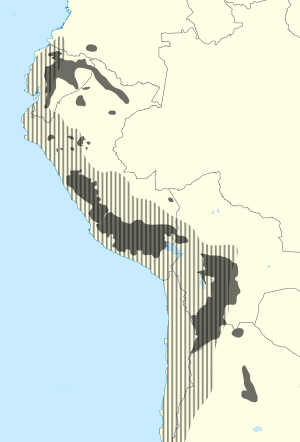Quechua people facts for kids
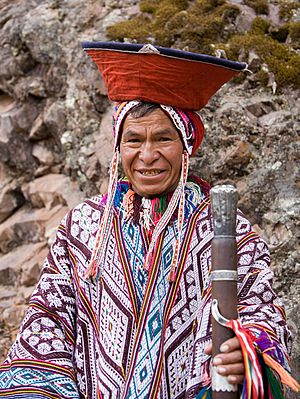
An Andean man in traditional dress. Pisac, Peru.
|
|
| Total population | |
|---|---|
| 9–8 million | |
| Regions with significant populations | |
| 6,694,300 | |
| 2,056,000 | |
| 700.000 | |
| 55.493 | |
| 36 700 | |
| 14,000 | |
| Languages | |
| Quechua • Spanish | |
| Religion | |
| Roman Catholicism • Protestantism • Traditional | |
| Related ethnic groups | |
| Aymaras | |
| Person | Runa / Nuna |
|---|---|
| People | Runakuna / Nunakuna |
| Language | Runasimi / Nunasimi |
The Quechua people are a group of native people who live in South America. They speak Quechua languages. These languages first developed among the Indigenous people of Peru. Most Quechua speakers live in Peru. However, many also live in Ecuador, Bolivia, Chile, Colombia, and Argentina.
The most common Quechua language is Southern Quechua. People in Ecuador speak the Kichwa dialect. In Colombia, the Inga people speak Inga Kichwa. The Quechua word for a Quechua speaker is runa or nuna, meaning "person". The word for "people" is runakuna or nunakuna.
Contents
- Who were some historical Quechua groups?
- Quechua Identity and History
- Daily Life and Traditions
- Foods and Crops of the Quechua People
- Challenges Faced by Quechua People
- Quechua Beliefs and Mythology
- Traditional Medicine and Plants
- Traditional Clothing of the Quechua People
- Quechua-speaking ethnic groups
- Notable people
- See also
Who were some historical Quechua groups?
Many important groups from history spoke Quechua. Some of these include:
- The Chanka people, who lived in the Huancavelica, Ayacucho, and Apurímac areas of Peru.
- The Huanca people from the Junín Region of Peru. They spoke Quechua even before the Incas.
- The Inca, who built the largest empire before Europeans arrived.
- The Chincha, a trading kingdom in the Ica Region of Peru that no longer exists.
- The Qolla who lived in parts of Bolivia like Potosí and La Paz.
- The Cañari of Ecuador, who learned Quechua from the Inca.
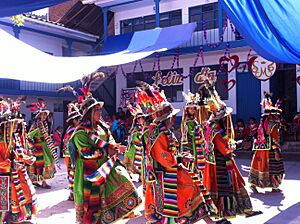
Quechua Identity and History
About 5.1 million people in Peru, 1.8 million in Bolivia, and 2.5 million in Ecuador speak Quechua. Smaller groups live in Chile and Argentina. Even though they share a language, different Quechua groups have their own unique identities. The various Quechua languages can be quite different. Sometimes, people speaking different Quechua languages cannot understand each other.
Quechua was not only spoken by the Incas. It was also spoken by groups who were sometimes enemies of the Inca Empire. These included the Huanca and the Chanka in Peru. Some groups, like the Huanca, spoke Quechua before the Incas of Cusco. Other groups, especially in Bolivia and Ecuador, started speaking Quechua during or after the Inca times.
In 1969, Quechua became Peru's second official language. This happened under the government of Juan Velasco Alvarado. Recently, some Quechua speakers have wanted to form their own "nation." This is especially true in Ecuador (Kichwa) and Bolivia. Groups like ECUARUNARI in Ecuador work to unite Kichwa peoples. Some even believe they should be a single, independent nation.
Daily Life and Traditions
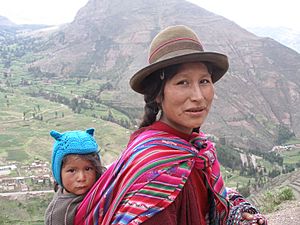
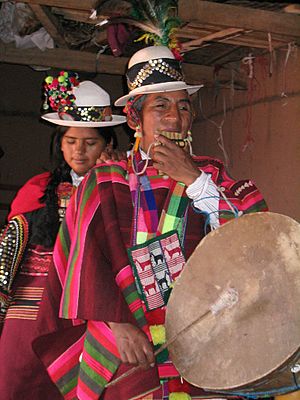
Even with their differences, Quechua groups share many cultural traits. They also share traditions with other native peoples of the central Andes. Traditionally, Quechua people identify strongly with their local area. Their way of life is closely tied to how they get food. This means farming in lower areas and raising animals in the higher Puna regions.
A typical Andean community uses land at different heights. This allows them to grow various crops and raise different animals. The land usually belongs to the local community, called an ayllu. It is either worked together or divided up each year.
Land Rights and Community Work
For a long time, large landowners took over much of the land. They forced native people to work for them. This led to very hard lives for the farmers. These harsh conditions often caused revolts, which were put down by force. A big revolt happened in 1780–1781, led by José Gabriel Kunturkanki.
In the mid-1900s, some native farmers took back their ancestors' lands. This happened during changes in government in Bolivia and Peru. The governments took land from large owners and gave it to native people. This changed some old traditions of shared land. However, ayllus still exist in remote areas today, like in the Quechua community of Q'ero.
The fight for land rights is still very important for Quechua people. Some Kichwa groups in Ecuador have won back their community lands. This sometimes happened through strong actions. For example, the Sarayaku community successfully stopped oil companies from taking their rainforest land.
Quechua people have two main types of shared work. Mink'a is when people work together for community projects. This could be building a new school. Ayni is when families help each other with big private projects, like building a house. They expect to be helped in return later.
Traditional Crafts and Homes
Many Quechua groups are known for their traditional handicrafts. Weaving is a very old tradition, passed down from Inca times. They use cotton and wool from llamas, alpacas, guanacos, and vicunas. They use many natural dyes and create beautiful patterns.
Houses are usually built from air-dried clay bricks called tika (or adobe). Sometimes they use branches and clay mortar. Roofs are covered with straw, reeds, or ichu grass.
When traditional ways of life change, for example, due to mining, it can affect Quechua identity and language. Many people also move to big cities like Lima. There, they often adopt the ways of Hispanic society.
Foods and Crops of the Quechua People

Quechua people grow and eat many different foods. They were among the first to grow potatoes. They have thousands of potato types, used for food and medicine. Quinoa is another important crop they grow.
Ch’arki is a Quechua word for dried meat. This is where the English word jerky comes from. Traditionally, it was made from llama meat, dried in the sun and frozen by cold Andean nights. Today, it can also be made from horse or beef.
Pachamanca is a Quechua word for a special cooking method. It means "earth pot." Food is cooked in a pit in the ground. It includes meats like chicken, beef, and lamb. It also has tubers like potatoes, sweet potatoes, and corn.
Guinea pigs are sometimes raised for meat. Other foods include meat from llamas and alpacas. They also eat beans, barley, hot peppers, coriander, and peanuts.
Challenges Faced by Quechua People
Quechua people have faced many challenges, including political conflicts and unfair treatment. In the 1980s, during a conflict in Peru, many Quechua people died. Most of the people fighting were not Quechua.
Quechua communities have often been left out of economic growth. The World Bank has noted that some countries in South America have very high rates of inequality. Many Quechua people have a shorter life expectancy than others in the region. Many communities also lack basic health services.
Unfair treatment based on ethnicity still happens. For example, in Peru, two newly elected members of parliament, Hilaria Supa Huamán and María Sumire, swore their oath in Quechua. This was the first time in Peru's history an oath was given in an Indigenous language. However, some parliamentary leaders refused to accept it.
Quechua Beliefs and Mythology
Most Quechua people in the Andes have been Catholic since colonial times. But they also keep many traditional religious beliefs. These old beliefs are often mixed with Christian ideas.
Quechua groups share traditional religions with other Andean peoples. They believe in Mother Earth, called Pachamama. She brings fertility, and people offer her gifts. Mountain spirits, called apu, are also important. There are also smaller local gods called wak'a. These are still honored, especially in southern Peru.
Quechua myths often tell stories about their history and struggles. One myth is about Nak'aq or Pishtaco, a white murderer who takes fat from native people. The Q'ero people have a myth called Wiraquchapampa. It tells about the Apus winning against the Spaniards. The Inkarrí myth is also popular in southern Peru. It connects different Quechua groups. Some Quechua people also see local foods like corn beer, chicha, coca leaves, and potatoes as having religious meaning.
Traditional Medicine and Plants
The bark of the cinchona tree contains Quinine. Quechua people used quinine for symptoms similar to malaria.
When chewed, coca leaves act as a mild stimulant. They can help with hunger, thirst, pain, and tiredness. Coca leaves are also used to help with altitude sickness. People often chew coca leaves while working in the fields or on construction projects.
Traditional Clothing of the Quechua People
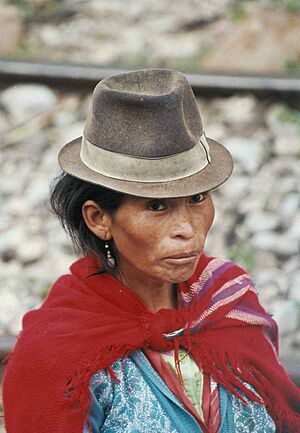

Many Indigenous women wear colorful traditional clothes. This often includes a bowler style hat. These hats have been worn by Quechua and Aymara women since the 1920s. British railway workers brought them to the country.
The traditional dress for Quechua women today mixes old styles with Spanish peasant clothes. From puberty, girls start wearing many layers of petticoats and skirts. The more layers a young woman wears, the more her family's wealth is shown. This made her a more desired bride. Married women also wear many layers.
Younger Quechua men often wear Western-style clothes. This includes synthetic football shirts and tracksuit pants. In some areas, women also wear Western clothes. Older men still wear dark wool pants that reach their knees. A woven belt called a chumpi is also worn. It helps protect the lower back when working. Men's formal clothing includes a woollen vest called a chaleco. These can be very decorated.
The most special part of men's clothing is the handwoven poncho. Almost every Quechua man and boy has a poncho. They are usually red with detailed designs. Each area has its own unique pattern. In some villages, ponchos are worn every day. But most men wear them for special events like festivals or weddings.
Like the women, men wear ajotas. These are sandals made from recycled tires. They are cheap and last a long time.
A ch'ullu is a knitted hat with earflaps. The first ch'ullu a child gets is traditionally knitted by his father. In the Ausangate region, ch'ullus are often decorated with white beads and large tassels. Men sometimes wear a felt hat called a sombrero over their ch'ullu. This hat is decorated with special bands. For a long time, men have carried small woven pouches called ch'uspa. These are used to carry their coca leaves.
Quechua-speaking ethnic groups
This list shows some of the Quechua ethnic groups. Their exact borders can change. Some are small village communities, while others have over a million people.
- Inca (historic)
Peru
Lowlands
- Kichwa-Lamista
- Southern Pastaza Quechua
Highlands
Ecuador
- Amazonian Kichwas
- Otavalos
- Salasaca
Bolivia
- Kolla
- Kallawaya
Notable people
- Túpac Amaru II, Revolutionary
- Angélica Mendoza de Ascarza, Human rights activist
- Kimberly Barzola, community organizer and artist
- Benjamin Bratt, Peruvian-American actor
- Manco Cápac, Sapa Inca
- Martín Chambi, Photographer
- Edison Flores, Footballer
- Oswaldo Guayasamín, Ecuadorian painter
- Ollanta Humala, former President of Peru
- Izkia Siches, doctor, Chilean politician
- Josh Keaton, Peruvian-American actor
- Q'orianka Kilcher, Actress
- Magaly Solier, Actress
- Diego Quispe Tito, Painter
- Alejandro Toledo, former President of Peru
- Juan Manuel Vargas, Footballer
- Yoshimar Yotún, Footballer
- Francisco Tito Yupanqui, Sculptor, Saint
- Luzmila Carpio, Musician, Activist
- Rodrigo Cuba, footballer
- Delfín Quishpe, musician, Ecuadorian politician
- Iván Kaviedes, footballer
- José Granda, footballer
- Luis Saritama, footballer
- Joao Ortiz Chilean-Peruvian footballer
- Miguel Vargas, Chilean-Peruvian footballer
- Renata Flores Rivera, Musician
See also
 In Spanish: Pueblo quechua para niños
In Spanish: Pueblo quechua para niños
- Kichwa
- Inkarrí
- Yanantin
- Sumak Kawsay
- Andean textiles
- Chuspas
- Chakitaqlla
- Chinchaypujio District
- Quechuan languages
- Indigenous peoples in Argentina
- Indigenous peoples in Bolivia
- Indigenous peoples of Peru
- Indigenous peoples in Ecuador





